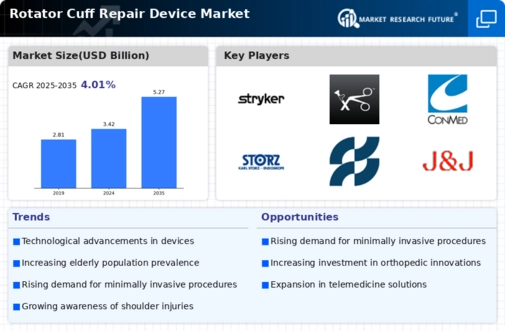Rising Sports Participation
The Rotator Cuff Repair Device Market is significantly influenced by the increasing participation in sports and physical activities. As more individuals engage in sports, the incidence of shoulder injuries, particularly rotator cuff tears, is on the rise. Data indicates that sports-related injuries account for a substantial percentage of rotator cuff repairs, with an estimated 25% of all cases linked to athletic activities. This trend is particularly evident among younger populations, who are more likely to engage in high-impact sports. Consequently, the demand for effective rotator cuff repair devices is expected to grow, as athletes and active individuals seek timely and effective treatment options. The rising awareness of the importance of shoulder health in sports further propels this market, making it a critical driver in the Rotator Cuff Repair Device Market.
Increased Healthcare Expenditure
The Rotator Cuff Repair Device Market is benefiting from the rising healthcare expenditure observed in various regions. As governments and private sectors allocate more resources to healthcare, there is a corresponding increase in funding for surgical procedures, including rotator cuff repairs. This trend is particularly evident in developed economies, where healthcare spending has seen a consistent upward trajectory. Data indicates that healthcare expenditure is projected to grow by 5% annually, which is likely to enhance access to advanced surgical techniques and devices. Consequently, this increase in funding is expected to facilitate the adoption of innovative rotator cuff repair devices, thereby driving market growth. The emphasis on improving surgical outcomes and patient care further underscores the importance of this driver in the Rotator Cuff Repair Device Market.
Growing Awareness of Shoulder Health
The Rotator Cuff Repair Device Market is also propelled by the growing awareness of shoulder health among the general population. Educational campaigns and initiatives aimed at promoting shoulder health are becoming more prevalent, leading to increased recognition of the importance of timely treatment for rotator cuff injuries. As individuals become more informed about the risks associated with untreated shoulder injuries, the demand for effective repair solutions is likely to rise. Recent surveys indicate that nearly 60% of individuals are now aware of the potential long-term consequences of rotator cuff injuries, which has led to a proactive approach in seeking medical advice. This heightened awareness is expected to drive the market for rotator cuff repair devices, as patients actively pursue treatment options to maintain their shoulder health.
Aging Population and Associated Health Issues
The Rotator Cuff Repair Device Market is notably driven by the aging population, which is increasingly susceptible to musculoskeletal disorders, including rotator cuff injuries. As individuals age, the likelihood of degenerative changes in the shoulder increases, leading to a higher incidence of rotator cuff tears. Recent statistics suggest that approximately 50% of individuals over the age of 60 experience some form of shoulder pain, with many requiring surgical intervention. This demographic shift is expected to result in a growing demand for rotator cuff repair devices, as healthcare systems adapt to the needs of an older population. The increasing prevalence of chronic conditions associated with aging further emphasizes the necessity for effective repair solutions, positioning this factor as a key driver in the Rotator Cuff Repair Device Market.
Technological Advancements in Surgical Techniques
The Rotator Cuff Repair Device Market is experiencing a surge in technological advancements that enhance surgical outcomes. Innovations such as minimally invasive techniques and robotic-assisted surgeries are becoming increasingly prevalent. These advancements not only reduce recovery times but also improve the precision of repairs, leading to better patient outcomes. According to recent data, the adoption of these technologies has led to a 30% increase in successful repair rates. As healthcare providers seek to offer the best possible care, the demand for advanced rotator cuff repair devices is likely to rise, driving market growth. Furthermore, the integration of imaging technologies, such as MRI and ultrasound, into surgical planning is expected to further refine the repair process, making it a pivotal driver in the Rotator Cuff Repair Device Market.

















Leave a Comment